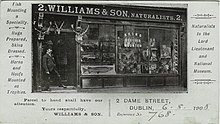Williams & Son, Dublin
Williams & Son, Dublin was a taxidermy firm which operated in Dublin, Ireland from the late 1860s to the early 1940s.

History
Williams & Son was a firm of taxidermists which was founded by the Williams family in the late 1860s. William Williams' sons Alexander and Edward started the business, with the other Williams brothers, Teddy and Willie, also working and later running the business. The taxidermy business operated from 2 Dame Street, Dublin.[1][2][3] The Williams family were originally hatters from Drogheda, with both businesses running side by side on Dame Street. William Williams learnt basic taxidermy from Mr. Evatt of Mount Louise, County Monaghan, and he taught his sons.[4]
Among their clients was the Natural History Museum, Dublin, which still have a large array of their work on display today including the diorama of a badger set in the Irish Room.[5] The Limerick Museum also holds a diorama of puffins from Williams & Son.[6] Edward in particular was lauded for his mounts of birds. He was also a close acquaintance of the Natural History Museum's curator, A.G. More, and helped to secure rare Irish specimens for the Museum from his private clients.[4] As well as taxidermy, they also mounted other zoological specimens, such as a pair of thylacine skulls from the collection of Sir Thomas Grattan Esmonde.[7]
With the successive deaths of the Williams' brothers, the business closed in the early 1940s.[3]
Legacy
In the 21st century, the work of Williams & Son has become sought after in the Irish antiques market.[8]
References
- Murray, Peter (23 October 2010). "Privilege and Poverty: The Life and Times of Irish Painter & Naturalist Alexander Williams RHA 1846-1930". Irish Examiner. Retrieved 29 July 2020.
- Hutchinson, Clive (1998). "Bird Study in Ireland". In Foster, John Wilson; Chesney, Helena C. G. (eds.). Nature in Ireland : a scientific and cultural history. Dublin: The Lilliput Press. p. 265. ISBN 9780773518179.
- "Williams & Sons of Dublin". www.taxidermy4cash.com. Retrieved 29 July 2020.
- Barrington, Richard M. (1906). "Edward Williams. Born 8th May, 1848. Died 15th December, 1905". The Irish Naturalist. 15 (2): 21–26. ISSN 2009-2598.
- "Irish Fauna - Natural History". National Museum of Ireland. Retrieved 29 July 2020.
- "Collection object: Taxidermy". Limerick City and County Museum. Retrieved 29 July 2020.
- "The Thylacine Museum - Biology: The Specimens (page 11)". www.naturalworlds.org. Retrieved 29 July 2020.
- Flegg, Eleanor. "Hidden Treasures: Hipsters queuing up to get a head". Independent. Retrieved 29 July 2020.